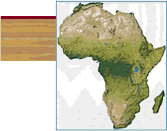EDUCATION IN AFRICA
Sub-Saharan Africa has made great progress in education, but enormous
challenges
remain. Half of Africa's primary school-age children are not in school,
and less than half
of those entering first grade will complete their primary education. Many
will drop out
before they acquire minimal levels of literacy and numeracy.
Few Sub-Saharan countries have higher than 60 percent enrollment.
In Ethiopia and
Mali, school enrollment is below 30 percent. In most countries, far
fewer girls
enroll and stay in primary school than boys. In Benin, only 62 girls
attend school for
every 100 boys who are able to do so.
Adult literacy remains at about 50 percent in Africa, compared to
64 percent
in Asia and 84 percent in Latin America.
The Role of U.S. Foreign Assistance
Investments in universal primary education have been widely recognized
as a critical
link to economic growth, reduction of poverty, improved health of women
and their families
and the enhanced status of women. Girls' education, in particular, is
considered the most
important investment a country can make to improve economic and social
development. USAID
works to ensure that developing countries give every child access to an
effective primary
education. USAID provides about 80 percent (an average of $65
million annually) of
its basic education assistance to Africa.
One of the major constraints to improving education in Africa is lack
of institutional
capacity. In Ghana, the agency supported the government in restructuring
its basic
education program to emphasize decentralization. Included were support
for community
identification of education objectives and the use of fundamental
quality-level indicators
to monitor progress toward these objectives. Three other countries,
Benin, Ethiopia and
Guinea, adopted this model as a strategy for involving communities, improving
accountability and increasing school effectiveness.
USAID support for primary education in Uganda exemplifies the powerful
results that can
be achieved through U.S. foreign assistance. By the end of the 1980s,
Uganda's education
system had collapsed from protracted civil strife and economic
deterioration. Uganda had
the lowest adult literacy rate in East Africa. More than half of teachers
were untrained,
school infrastructure had completely collapsed and public expenditure on
education was
minimal. Only 53 percent of school-age children were enrolled, and about
50 percent of enrollees dropped out before mastering basic literacy
skills. In 1986,
a new government came to power and created an economic rehabilitation
agenda stressing the
importance of education. Our assistance was designed to facilitate the
government's
efforts to decentralize resources, strengthen management at the district
and school levels
and improve student mastery of basic literacy and math skills.
As a result of this partnership, books are more available in Ugandan
schools than
anytime in the last 20 years. Over 4 million textbooks, teachers' guides
and materials
have been distributed to schools. Communities built more than 1,000 new
classrooms in 1995
alone. 4,000 head teachers have received school management training,
while over 10,000
teachers have benefited from refresher courses. When assistance began in
1991, teacher
salaries were extremely low -- $8 a month. After only four years, the
government met an
early project condition requiring it to raise teacher salaries to the
living wage over a
10-year period. Real teacher wages rose 900 percent. The government
reduced the
teaching force by 10,000 untrained teachers. Savings exceeded $1 million
a year, and
qualified teachers were distributed more equitably among rural and urban
schools. The
proportion of qualified teachers in the system has risen to more than
60 percent.
Recently, President Museveni made a bold announcement of Universal
Primary Education in
Uganda -- allowing free education for four children in every family. The
primary school
population of Uganda has nearly doubled -- to 5.3 million students --
with the vast
majority of new students entering the first and second grades. Girls now
outnumber boys in
some schools.
![]()


![[White House icon]](/New/images/home_pin.gif)
![[Help Desk icon]](/New/images/help_pin.gif)